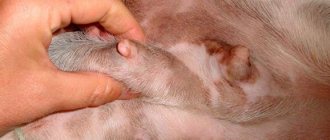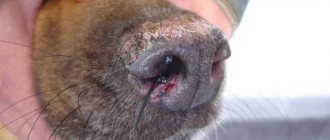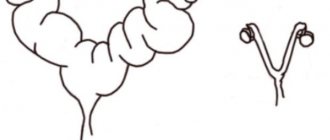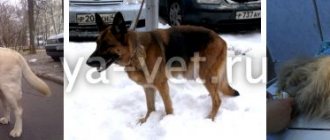Hypothyroidism in dogs is a common disease of the endocrine system that develops due to insufficient production of thyroid hormones. To maintain a normal quality of life, animals with this diagnosis require lifelong treatment based on hormonal medications.
What is hypothyroidism
Before moving on to the main causes and symptoms, it is necessary to understand the peculiarities of the functioning of the thyroid gland. This will help to understand the nature of the pathology.
How the thyroid gland functions
The thyroid gland is an important organ of the endocrine system, located between the larynx and trachea. It regulates metabolism, stimulates protein synthesis and is responsible for saturating tissues with oxygen. All these functions are achieved with the help of thyroid hormones:
- T3, or triiodothyronine;
- T4, or thyroxine.
Their secretion is regulated in the hypothalamus, a small area in the diencephalon. Another hormone is synthesized here - thyrotropin-releasing hormone, which affects the pituitary gland - another part of the brain. It promotes the production of thyroid-stimulating hormone, or TSH, which stimulates the functioning of thyroid cells.
The described cycle also works in the opposite direction. Active forms of T3 and T4 can slow down the synthesis of thyrotropin-releasing hormone and TSH. The ability to self-regulate allows you to maintain internal balance.
Occurrence and description of pathology
The essence of the pathology lies in the insufficient synthesis of thyroid hormones in the dog or in their excessive utilization. In both cases, a reduction in the normal amount of T3 and T4 leads to metabolic disorders and disruptions within the body. TSH production increases, which can result in depletion of its synthesis. In severe cases, the disease is accompanied by coma, increasing the likelihood of death to 50%.
The disease can be acquired or congenital. In the second case, a breed predisposition can be traced.
Breed predisposition
Most often, the pathology is diagnosed in miniature schnauzers, cocker spaniels, Airedale terriers, golden retrievers, Great Danes, dachshunds, poodles, boxers, Doberman pinschers, Irish setters, bobtails, Irish wolfhounds and German shepherds. About 70% of cases occur in representatives of large and giant breeds aged 4-10 years.
The disease often occurs in spayed female dogs. Despite this, castration surgery remains justified, since the mortality rate from uterine cancer is much higher.
Causes of thyroid hormone deficiency
Cases of congenital disease are quite rare. If during pregnancy the bitch had problems with the production of hormones, then a similar problem will affect her offspring.
Puppies may also develop concomitant endocrine disorders: cretinism or dwarfism. These pathologies are characterized by problems with socialization (lack of response to affection and aggression) and short stature.
A disease that appears during life is called acquired. It is caused by the following reasons:
- autoimmune diseases (pathological production of autoimmune bodies that destroy healthy cells of one’s own body);
- infections and helminthiasis;
- improper diet (frequent consumption of chicken containing hormonal supplements);
- inflammation, tumors and injuries of the thyroid gland, as well as surgery to remove it;
- diseases of internal organs (heart or kidney failure);
- atrophy of thyroid tissue caused by obesity or cancer;
- uncontrolled use of hormonal drugs;
- iodine deficiency.
Symptoms and signs of hypothyroidism in dogs are similar, and treatment depends on the cause. Based on its origin, the disease is divided into 3 types.
Symptoms of Hyperthyroidism in Dogs
The maximum frequency of registration of hyperthyroidism in dogs is based on the following characteristics:
- breed: Keeshond, in second place is Labrador Retriever and Doberman. All dogs have a tendency to develop the disease;
- age: from seven years and more. There is evidence that in such animals changes in the thyroid gland begin at about 2 years of age.
The first signs of the disease are:
- change in behavior: restlessness, agitation or lethargy, in some cases aggression;
- sudden increase or decrease in weight: a dog may consume large amounts of food, but suddenly lose weight;
- cardiopalmus;
- digestive and breathing disorders;
- increased body temperature;
- trembling of limbs;
- thirst;
- hair loss and thickening of nails.
In very complex cases, the most striking sign of hyperthyroidism in a dog may be the so-called “bulging eyes” or Graves’ disease. It is described in classic textbooks on veterinary medicine as follows: “... the dog exhibits a special kind of “bulging eyes,” that is, the eyeball sharply moves outward ...”, and visually it seems that the animal has huge eyes.
The thyroid gland itself is enlarged on the right and left (in almost 70% of the examined animals). Processes in it can go in two directions. The first is when the iron increases due to an increase in the amount of the colloid itself. The second is when the gland enlarges due to the proliferation of connective tissue (septa). This gland condition is called goiter; fortunately, it develops extremely rarely in dogs.
An atypical (uncharacteristic) form of hyperthyroidism in dogs has also been described:
- poor appetite;
- exhaustion and weakness;
- depression.
As the disease progresses and internal organs are involved, symptoms may increase. In advanced cases, the animal may die.
Dividing the disease into types
When mentioning classification, one should remember the circulation between the organs of the endocrine system. Depending on the location of the failure, the disease can be:
- primary, when the problem arises in the gland itself;
- secondary, arising due to insufficient stimulation of the pituitary gland;
- tertiary, manifested due to a lack of neurohormones in the hypothalamus.
Most often, veterinarians diagnose the primary type, which is caused by an autoimmune disorder. This immune system defect is called Hashimoto's thyroiditis.
Course of the disease by stages
At the early stage of the disease, there is a sharp reduction in tyrosine, the amino acid from which T3 and T4 are synthesized. To replenish it, the body sharply increases the production of other hormones, leveling the balance. In rare cases, self-healing is possible, but most often the pathology becomes more severe.
At a later stage, the decrease in tyrosine levels is so noticeable that it is no longer possible to equalize the balance on your own. The thyroid gland suffers serious damage, which is reflected in a sharp deterioration in the condition of the sick animal.
Causes of the disease
There can be many reasons why a dog's thyroid gland begins to produce too much or not enough hormones. Most often these are the following problems and conditions:
- Congenital pathologies.
- Heredity.
- Irradiation, especially with radioactive iodine.
- Changes in hormonal levels during intrauterine development of the fetus.
- Taking certain medications.
- Malfunctions of the pituitary gland, hypothalamus and the thyroid gland itself.
- Traumatic effects on the organ.
- Disorders of the development and functioning of the thyroid gland.
- Gland tumors - benign or malignant.
It is quite difficult to identify the cause of malfunctions in the functions of an organ, so the disease is most often detected already in the process of active development.
Symptoms of disorders
The diagnosis is rarely made at the initial stage, since the owners practically do not notice the changes occurring. First of all, the deterioration of the condition manifests itself in rapid fatigue, increased drowsiness, apathy and a decrease in body temperature. Excessive lethargy and attempts to seek out warm places are usually associated with age.
A more obvious sign is hypotrichosis, a hair growth disorder leading to alopecia. In the photo of dogs with hypothyroidism, you can see baldness in the groin, armpits and neck - the places that are subject to the most frequent friction.
Before the appearance of focal alopecia, slow hair growth is observed. It can be detected by maintaining regular haircuts. Over time, balding areas darken due to hyperpigmentation caused by excess melamine. Light-colored animals may develop acne.
Violation of protein synthesis leads to keratinization of the epidermis and roughening of the skin. The sebaceous glands atrophy and produce less and less sebum. Problems with blood flow and developing anemia are expressed in body temperature. The skin of a sick animal becomes not only rough and thick, but also unusually cold. The wounds that appear take longer to heal than usual.
The slowing of lymph flow is accompanied by swelling of the muzzle, neck and chest. The facial expression becomes sad regardless of the pet’s mood.
The remaining symptoms are nonspecific and occur against the background of concomitant disorders:
- itching, indicating a secondary infection;
- muscle weakness and lameness;
- corneal ulcers and uveitis;
- purulent inflammation of the skin;
- frequent regurgitation of food and constipation;
- paralysis of the larynx and one side of the muzzle;
- perversion of taste;
- obesity;
- slowing heart rate and pulse rate.
Pathology can cause infertility. In sick males, sexual activity decreases, and in females, the intervals between estrus lengthen. If the cycle persists, then there is a high probability of developing a false pregnancy.
It is pointless to treat associated complications without eliminating the root cause, since they are sure to recur. For this reason, it is necessary to correctly diagnose and normalize the functioning of the endocrine system.
Diagnostics: what tests need to be taken?
Diagnosis of hypothyroidism in dogs is based on determining the level of main hormones (T3, T4, TSH) in the blood serum. The disease is confirmed if there is a significant deviation from the norm and the presence of accompanying symptoms.
One common complication is hyperlipidemia, which is an abnormally high level of fat in the blood. With this disorder, the sick animal experiences an increase in cholesterol and triglycerides.
Additional research methods include general urine and blood tests, ECG, cardiac echocardiography, ultrasound and biopsy. The last two studies are carried out only if neoplasms are suspected, in order to exclude or refute the presence of a tumor.
It is worth noting that the diagnosis is often made incorrectly. This is due to the fact that the content of total T4 is influenced by many extraneous factors:
- malignant neoplasms;
- chronic liver pathologies;
- infections;
- renal failure.
It is more reliable to rely on the value of free T4, which does not change with systemic diseases and decreases only with problems with the thyroid gland. The problem is that research on this indicator is not available in most veterinary clinics.
Diagnosis of the disease
Hypothyroidism in dogs is diagnosed based on the results of several tests. Their choice depends on the financial capabilities of the animal owners, the availability of modern equipment and the necessary reagents in the clinic. Since the signs of this disease are quite vague, it will not be possible to do without professional clinical diagnosis.
The most common test is a thyroxine (T4) test. This substance can only be synthesized by the thyroid gland. Therefore, when its content in the bloodstream is low, the presence of this serious disease can be assumed. However, it should be taken into account that there are a number of other reasons that provoke a decrease in thyroxine in the blood, so it is necessary to consider other diagnostic methods.
Thyroxine can be present in the bloodstream in two forms. The bound form attaches to proteins and does not enter cells. Free T4 is not bound to proteins, it is able to penetrate cellular structures and, as a rule, is present in them in small quantities. Its volume fraction is taken into account when making a diagnosis.
If your dog has low T4 levels, a thyroxine test can be done based on the effects of specific medications. In this case, a small amount of pituitary synthetic hormone is injected intravenously. Six hours after the procedure, the dog's blood is drawn and the T4 level is checked. If an animal is confirmed to have hypothyroidism, the level of the hormone in its blood will be close to normal levels. In a healthy dog, the level of this substance will significantly exceed the upper limits of normal.
Routine tests performed as part of a clinical examination can provide valuable information. To do this, you need to do the following:
- biochemical blood test with determination of triglyceride and cholesterol levels and general clinical;
- urine test (general);
- echocardiography;
- electrocardiogram.
Therapeutic measures
Treatment is based on gradually increasing the amount of missing hormones using their synthetic analogues. Positive changes are observed in the first 10 days from the start of taking hormonal drugs. All concomitant pathologies are treated in parallel.
Medications
Levothyroxine is used as the main drug. It is sold in human pharmacy and is used to treat a similar disease in humans. Despite this, the required dose of thyroxine for dogs and their owners is very different. You should not trust pharmacists who offer to buy a smaller dose or try to adjust the dosage yourself by reading the instructions.
Do not worry about the complications of overdose indicated inside the package. The half-life in the dog's body is less than in the human body. For this reason, dogs always require a larger dose of the substance, as otherwise it does not produce the desired effect. The veterinarian selects a safe and effective dose individually, based on the tests of the four-legged patient.
If treatment involves additional administration of salicylates and glucocorticosteroids, then the dosage is increased. This is necessary due to the suppression of the protein binding capacity necessary for the smooth circulation of T3 and T4. In case of systemic diseases (diabetes mellitus, congestive heart failure), the dosage, on the contrary, is reduced.
The first improvements are noted when T4 approaches the upper limit of normal. The pet gradually returns to normal activity.
Recovery from alopecia takes much longer. An obvious difference can be seen by comparing the photo before treatment of hypothyroidism in a dog and 3 months after.
If the recommended dosage is exceeded, symptoms of hyperthyroidism may occur - a reverse pathology consisting in excess production of hormones. In this case, the animal’s breathing becomes intermittent and frequent, and apathetic behavior gives way to anxiety and aggression.
The drug cannot be discontinued even if there are complications, as the disease may return. To eliminate the symptoms that arise, it is enough to reduce the dosage in consultation with a veterinarian.
Diet and care
Treatment of any disease is not complete without a review of nutrition. To relieve the burden on a weakened body, the animal is prescribed medicinal food or easily digestible natural food. More detailed instructions depend on your symptoms.
If your pet suffers from constipation, then more fluid needs to be added to its diet. Pouches or canned liquid food, meat broths and milk porridges will help with this. If the problem lies in diarrhea, then it is recommended to use rice porridge to consolidate the stool.
Due to low physical activity and rapid weight gain, the usual portions should be reduced and the frequency of feedings increased. Dry food with low carbohydrate content gives good results. To stabilize the level of iodine, selenium, zinc and other important elements, the dog will have to drink special complexes prescribed by the veterinarian.
No special care is required for a sick animal. It is enough to keep him warm and not tire him out with too long walks, remembering impaired heat exchange and anemia.
What are the forecasts?
There is no cure for hypothyroidism in dogs, but it can be successfully controlled with lifelong hormonal medications and regular blood tests. This therapy eliminates relapses and complications, allowing the pet to live a full life.
If taking medications does not provide improvement within 2-3 months, then the diagnosis is considered erroneous. In this case, the examination is repeated, focusing on identifying pathologies with similar symptoms.
Due to its asymptomatic course at an early stage, hypothyroidism in dogs can only be detected by laboratory test results. If your pet is at risk, be sure to undergo all the necessary tests and be checked by a veterinarian for preventive purposes at least once a year.
The article is for informational purposes only. Contact your veterinarian!
Diagnosis of hyperthyroidism in dogs
- Questioning about the history of the disease and examination of the dog.
- To understand the condition of the body, a general blood and urine test is prescribed.
- Blood test for hormones.
- Electrocardiography - to monitor the cardiovascular system, ultrasound (Fig. 3) and x-rays - to exclude tumor processes and metastases in the chest cavity.
- Other studies based on the general condition of the animal.
Rice. 3. Hyperthyroidism in a Labrador. Ultrasound of the left lobe of the thyroid gland.
When treating hyperthyroidism, it is necessary to monitor the dog's condition with repeated examinations, some laboratory tests (complete blood count, hormone levels) every 2-3 weeks, at least for the first 3 months, then as necessary.











